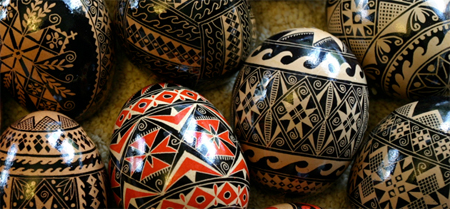The colors used in pysanka are rich in symbolism:
WHITE – purity, birth, light, rejoicing, virginity
YELLOW – light and purity. It is the color consecrated to the light deities, and the sun, stars, and moon. It the Christian symbol of reward and recognition.
GOLD – spirituality and wisdom
ORANGE – endurance, strength and ambition. It is also the symbol of the everlasting sun.
PINK– success and contentment
GREEN – fertility, health and hopefulness; of spring, breaking bondage, freshness and wealth. It is the color of Christmas, Easter and the Epiphany.
RED – the magical color of folklore signifying action, charity and spiritual awakening. It also represents the sun and the joy of life and love. In the Christian era, it represents the divine love and passion of Christ, hope, passion, blood, fire and the ministry of the church.
BLUE – blue skies, the air, good health, truth and fidelity
PURPLE – fasting, faith, trust and patience
BROWN – Mother Earth and her bountiful gifts; earth, harvest, generosity
BLACK – eternity, the center of the Earth and the darkest time before dawn. Black also signified death, fear, and ignorance.
Combination of colors
BLACK and WHITE – mourning and respect for the souls of the dead
BLACK and RED – ignorance arising from passions
RED and WHITE – respect and protection from evil
FOUR or MORE COLORS – family happiness, peace and love
Each symbols also have their own meanings. The most popular ones are geometric such as the triangle (the Holy Trinity and the elements of air, fire and water), diamonds (knowledge) and dots (tears of the blessed Virgin). 
My dad's family must have been from the Lembo area of the Ukraine because the eggs we created were the drop-pull style using a pin-head as shown above. I remember spending hours with my mother, aunt, siblings and cousins creating our beautiful pysanky for Easter. My mother and aunt since have passed so it has been years since the rest of the family spent a day decorating pysanky. But if I close my eyes, I can still see the vivid hues and intricate patterns of those beautiful pysanky.
Information on symbolism, traditions and even instructions on how to create these beautiful pysanky can be found on Luba Petrusha's web site. Her pysanky are amazing and she was kind enough to let me share these works of art with my readers.






These are gorgeous works of art. I love the amazing colors and intricate detail work! Happy Easter to you Maryanne!
ReplyDeleteHappy Easter to you too, Pat! I've been surrounded by these special little jewels all my life. Now do you understand my obsession with color and patterns! This probably contributed toward me being a graphic designer.
ReplyDeleteGreat article, beautiful pysanky thanks for showing the artistic talent. Dripping wax with a pin is a technique I haven't tried yet.
ReplyDeleteMy grandmother made them in Burlington, NC and she was Methodist and English descent, so I'm guessing she must have had a friend with this heritage? I only saw her 5 times because we lived in St. Louis. She did not blow the eggs out.
ReplyDelete